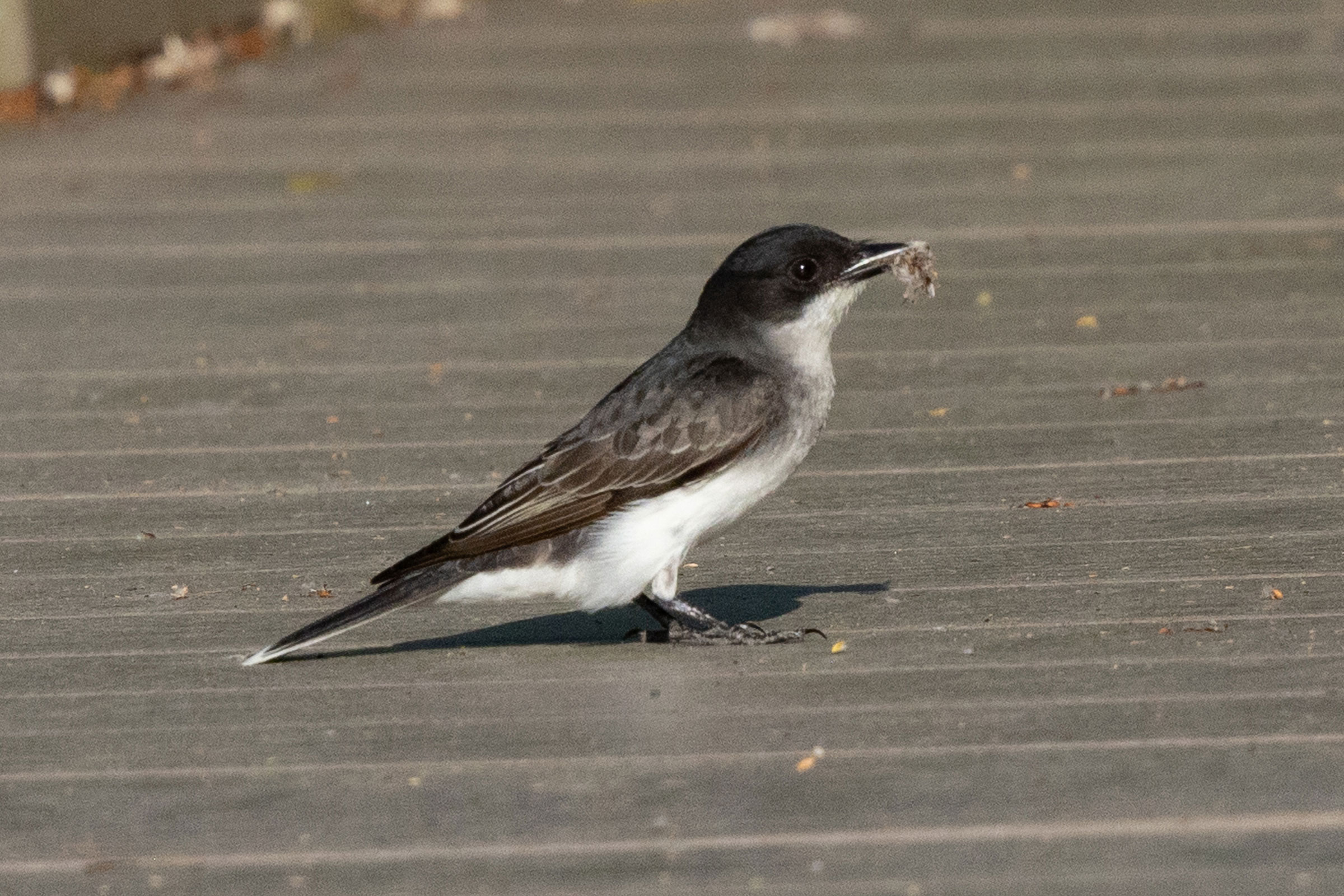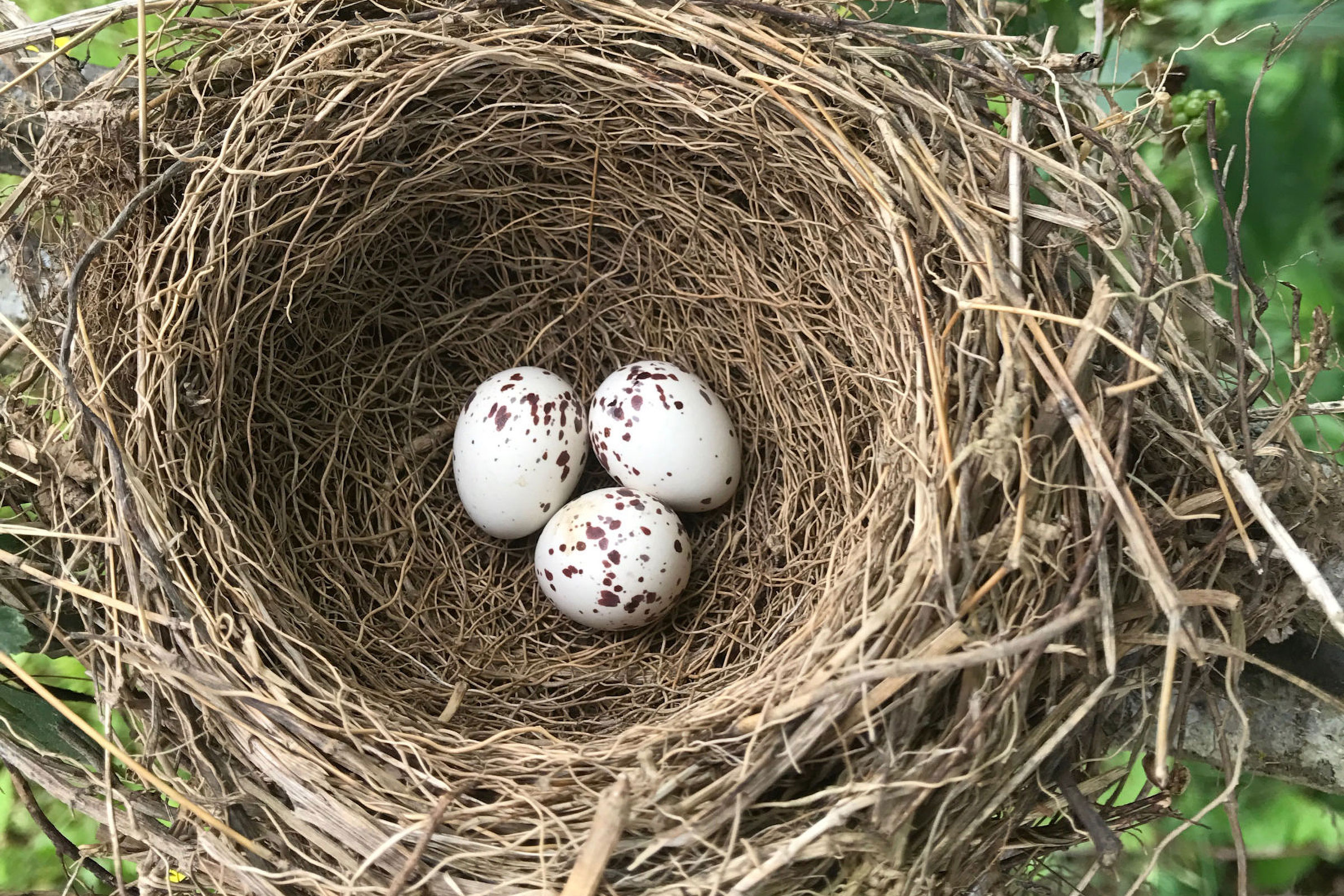Introduction
In rural Virginia’s farming valleys in June or July, one is likely to see Eastern Kingbirds perched on fence wires and atop shrubs in brushy fields. Look for a dark gray bird with light underbelly and tail feather tips that seem to have been dipped in white paint. Eastern Kingbirds can also be seen chasing off predators and competitors. This species earned the name “Kingbird” for taking on much larger birds, such as hawks, crows, and Blue Jays (Cyanocitta cristata) (Murphy and Pyle 2020).
Breeding Distribution
Eastern Kingbirds are found throughout the state, but they are less likely to occur in heavily forested areas (Figure 1). This pattern can be readily seen along extensively forested ridges in the Mountains and Valleys region and to a lesser extent in large forest patches in the Piedmont and Coastal Plain regions. In contrast, Eastern Kingbird occurrence is positively associated with agricultural lands (these can include association with hay/pasture if nesting at forested edge of field).
Between the First and Second Atlases (Figures 1 and 2), Eastern Kingbird’s likelihood of occurrence remained constant across the entire state, except for a small area of decrease in the southwestern portion of the Mountains and Valley region (Figure 3).

Figure 1: Eastern Kingbird breeding distribution based on probability of occurrence (Second Atlas, 2016–2020). This map indicates the probability that this species will occur in an Atlas block (an approximately 10 mi2 [26 km2] survey unit) based on environmental (including habitat) factors and after adjusting for the probability of detection (variation in survey effort among blocks).

Figure 2: Eastern Kingbird breeding distribution based on probability of occurrence (First Atlas, 1985–1989). This map indicates the probability that this species will occur in an Atlas block (an approximately 10 mi2 [26 km2] survey unit) based on environmental (including habitat) factors and after adjusting for the probability of detection (variation in survey effort among blocks). Blocks in white were not surveyed during the First Atlas and were not modeled.

Figure 3: Eastern Kingbird change in breeding distribution between Atlases (1985–1989 and 2016–2020) based on probability of occurrence. This map indicates the change in the probability that this species will occur in a block (an approximately 10 mi2 [26 km2] survey unit) between Atlas periods. Blocks with no change (tan) may have constant presence or constant absence. Blocks in white were not surveyed during the First Atlas and were not modeled.
Breeding Evidence
Eastern Kingbirds were confirmed breeders in 553 blocks and 106 counties and found to be probable breeders in an additional 10 counties (Figure 4). During the First Atlas, breeding observations were also recorded across Virginia (Figure 5).
Although the earliest evidence of breeding was nest building, documented in mid-April, breeding was primarily confirmed through observations of recently fledged young (May 23 – September 3), occupied nests (May 4 – August 10), and adults carrying food (May 8 – August 13) (Figure 6).
For more general information on the breeding habits of this species, please refer to All About Birds.

Figure 4: Eastern Kingbird breeding observations from the Second Atlas (2016–2020). The colored boxes illustrate Atlas blocks (approximately 10 mi2 [26 km2] survey units) where the species was detected. The colors show the highest breeding category recorded in a block. The numbers within the colors in the legend correspond to the number of blocks with that breeding evidence category.

Figure 5: Eastern Kingbird breeding observations from the First Atlas (1985–1989). The colored boxes illustrate Atlas blocks (approximately 10 mi2 [26 km2] survey units) where the species was detected. The colors show the highest breeding category recorded in a block. The numbers within the colors in the legend correspond to the number of blocks with that breeding evidence category.

Figure 6: Eastern Kingbird phenology: confirmed breeding codes. This graph shows a timeline of confirmed breeding behaviors. Tick marks represent individual observations of the behavior.
Population Status
Eastern Kingbird relative abundance was estimated to be highest in rural farming areas, such as the Shenandoah Valley, and on the Eastern Shore and lowest in heavily forested areas (Figure 7).
The total estimated Eastern Kingbird population in the state is approximately 245,000 individuals (with a range between 149,000 and 403,000). Based on the North American Breeding Bird Survey (BBS), the Eastern Kingbird population declined by a significant 2.02% annually from 1966–2022 in Virginia, and between Atlas periods, Eastern Kingbirds experienced a significant decrease of 1.54% per year from 1987–2018 (Hostetler et al. 2023; Figure 8).

Figure 7: Eastern Kingbird relative abundance (Second Atlas, 2016–2020). This map indicates the predicted abundance of this species at a 0.4 mi2 (1 km2) scale based on environmental (including habitat) factors. Abundance values are presented on a relative scale of low to high.

Figure 8: Eastern Kingbird population trend for Virginia as estimated by the North American Breeding Bird Survey. The vertical axis shows species abundance; the horizontal axis shows the year. The solid line indicates the estimated population trend; there is a 97.5% probability that the true population trend falls between the dashed lines. The shaded bars indicate the First and Second Atlas periods.
Conservation
In Virginia, the overall decline in Eastern Kingbird populations is likely associated with the change from family farms toward more intensive row-crop agriculture and reforestation of abandoned farms and other formerly open habitats. To address this decline, the 2025 Virginia Wildlife Action Plans classifies the Eastern Kingbird as a Tier IV Species of Greatest Conservation Need (Moderate Conservation Need), indicating that long-term planning may be necessary (VDWR 2025). Additionally, efforts implemented for other birds that inhabit shrublands, forest edges, and agricultural and open habitats will also benefit the Eastern Kingbird. Groups such as the American Bird Conservancy, Piedmont Environmental Council, and Virginia Department of Wildlife Resources provide management guidelines for birds in these habitats (Vuocolo et al. 2016).
Interactive Map
The interactive map contains up to six Atlas layers (probability of occurrence for the First and Second Atlases, change in probability of occurrence between Atlases, breeding evidence for the First and Second Atlases, and abundance for the Second Atlas) that can be viewed one at a time. To view an Atlas map layer, mouse over the layer box in the upper left. County lines and physiographic regional boundaries (Mountains and Valleys, Piedmont, and Coastal Plain) can be turned on and off by checking or unchecking the box below the layer box. Within the map window, users can hover on a block to see its value for each layer and pan and zoom to see roads, towns, and other features of interest that are visible beneath a selected layer.
View Interactive Map in Full Screen
References
Hostetler, J. A., J. R. Sauer, J. E. Hines, D. Ziolkowski, and M. Lutmerding (2023). The North American breeding bird survey, analysis results 1966–2022. U.S. Geological Survey, Laurel, MD, USA. https://doi.org/10.5066/P9SC7T11.
Murphy, M. T. and P. Pyle (2020). Eastern Kingbird (Tyrannus tyrannus), version 1.0. In Birds of the World (P. G. Rodewald, Editor). Cornell Lab of Ornithology, Ithaca, NY, USA. https://doi.org/10.2173/bow.easkin.01.
Virginia Department of Wildlife Resources (VDWR). 2025. Virginia wildlife action plan. Virginia Department of Wildlife Resources, Henrico, VA, USA. 506 pp.
Vuocolo, C., C. Sedgwick, S. Harding, F. Wolter, S. Capel, D. Pashley, and S. Heath (2016). Managing land in the Piedmont of Virginia for the benefit of birds and other wildlife: third edition. Piedmont Environmental Council, Warrenton, VA, USA.







